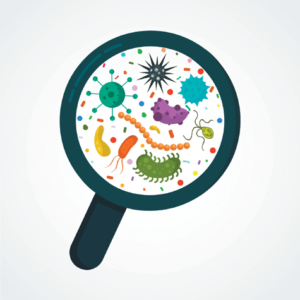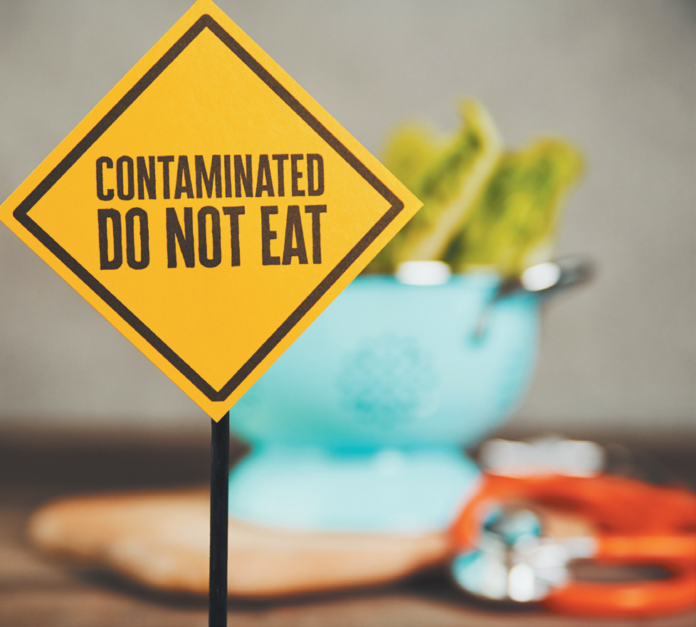Making healthy food choices is hard enough without worrying about the additional potential health impact of things like pesticide residues, environmental contaminants, and rogue bacteria. Fortunately, a little knowledge can help you take control of your food safety and calm those worries.
Salmonella, Campylobacter, and E. coli Infection. Outbreaks of disease from Salmonella, Campylobacter, and Escherichia coli (E. coli) bacteria, albeit unusual, have been traced to all kinds of foods. Most common are undercooked eggs, poultry, and meats, raw milk, and even raw fruits and vegetables. How worried should you be about getting infected?
Infections from foodborne bacteria typically cause nausea, vomiting, diarrhea, abdominal cramps, and fever. In healthy individuals, symptoms generally last from two to seven days and resolve on their own, but they can occasionally lead to more serious illness. For example, “with E. coli, some infections are very mild,” says John Leong, PhD, chair of Molecular Biology and Microbiology at Tufts University School of Medicine, “but a small percentage progress to very serious systemic illness such as kidney or neurological damage.”

Alice H. Lichtenstein, DSc, a professor at the Friedman School and executive editor of Tufts Health & Nutrition Letter reminds us it is important to put the magnitude of the risk in perspective. “As with many things in life, we must think in terms of risk/benefit,” says Lichtenstein. “Within the context of our current food supply, the benefits of eating lots of produce and other healthy foods such as nut butters far outweigh the risk of exposure to foodborne illness. And there are lots of things we can do to cut our risk, particularly with regard to how we handle food once it enters our homes.”
Act, Don’t Worry! Some basic food safety practices can help you avoid these worrisome bacteria. “Once we get food home, the responsibility for food safety is in our hands,” says Jeanne Goldberg, PhD, professor emerita at the Friedman School. “Just a few measures on your part can go a long way.” Based on the latest information, Goldberg and Leong recommend the following:
- Wash your hands well with soap before and after handling food.
- Rinse raw fruits and vegetables under running water before eating (unless they are pre-washed, such as bagged salad greens).
- Avoid rinsing raw meat or poultry.
- Keep foods that should be refrigerated, such as meat and dairy, cold (either in the refrigerator or freezer) if you’re not using them right away.
- Cook all foods to the appropriate internal temperature (see “Safe Internal Temperatures” chart). An instant-read thermometer is a worthwhile investment.
- Invest in two cutting boards, one for fruits and vegetables and the other for raw meat and seafood.
- Don’t consume undercooked eggs, raw milk, or unpasteurized dairy products and juices.
- Pay attention to news reports of specific products identified as causing outbreaks of foodborne illness, and discard any recalled items you have in your home.
| Beef | 145°F |
| Poultry | 165°F |
| Pork | 145°F |
| Ground Meats | 160°F |
| Fish & Shellfish | 145°F |
| Fully Cooked Ham | 165°F |
| Leftovers | 165°F |
| Casseroles | 165°F |

Environmental Contaminants. Compounds like mercury and arsenic exist naturally in our environment and are also introduced as contaminants from industrial and mining activities. High levels of exposure to these compounds over long periods of time are known to cause adverse effects. Methylmercury at high levels can damage the brain and nerves; arsenic increases risk for cancer.
For most of us, exposure is limited to the very small amounts of methylmercury found in fish and shellfish and the low levels of arsenic in some water supplies and foods. Regular testing of commercial fish and seafood by the U.S. Food and Drug Administration (FDA) finds nearly 90 percent of fish eaten in the U.S. have levels of methylmercury that do not raise human health concerns for most people. It is safe (and recommended) to eat most fish two to three times a week.
According to the FDA, adverse health effects from arsenic require levels much higher than those typically found in foods. Worldwide, water is a larger concern. In the U.S., arsenic levels in public drinking water are monitored and controlled.
Act, Don’t Worry! The benefits of eating fish and seafood two or three times a week, particularly when they replace less healthy choices, clearly outweigh the risks.
It is recommended that women who are pregnant or breastfeeding and children two and under avoid eating the fish highest in mercury (king mackerel, marlin, orange roughy, shark, swordfish, tilefish from the Gulf of Mexico, and bigeye tuna) and limit certain other species to only one serving a week (see Resources for more information). Fish are an excellent source of omega-3 fatty acids that are critical for normal brain development, but high methylmercury exposure can harm the developing brain (during pregnancy and the first two years of life).
Rice tends to absorb arsenic from water more readily than other crops, so people who base their diets around rice or gluten-free rice flour-based processed foods are encouraged to replace some of that rice with other grains. Parents of infants and toddlers are encouraged to choose a variety of fortified infant cereals (including oat, barley, and multi-grain) in addition to rice cereals.
If you get your water from a well, you should get the water tested every spring or early summer to make sure arsenic levels do not exceed 10 parts per billion (0.01 milligram per liter).
Pesticides. Pesticides are used to control insects, rodents, weeds, bacteria, mold, and fungus on food crops. People who work around pesticides (such as farm and pest control workers) have the largest exposure to these chemicals and can develop adverse health effects. Levels of pesticides on and in many foods in the U.S. are low.
The U.S. Environmental Protection Agency (EPA) is required to ensure pesticide residue on foods is at least ten times lower than the upper level of the amount determined to be safe for consumption. Scientists are continually working to develop safer, less toxic pesticides, and potential risk from exposure has declined over the years.
Follow this advice to make healthy dietary choices while decreasing any potential health consequences from exposure to environmental contaminants, pesticides, or bacteria:
- Don’t Skip Healthy Foods! The benefits of a healthy dietary pattern greatly outweigh the risks presented by potential contaminants.
- Wash Up. Wash all produce under running water to remove potential pesticide residue and harmful microbes.
- Make Informed Choices. Consider organic produce if it suits your budget and lifestyle. If you’re pregnant or breastfeeding, eat fish and shellfish, but just avoid a few species high in mercury, like swordfish and shark. (See Resources for more information.)
- Mix it Up. Eat a variety of foods to help ensure you are not getting repeated exposure to any trace contaminants in one kind of food.
Act, Don’t Worry! According to the EPA, only very small amounts of pesticides may remain in or on fruits, vegetables, grains, and other foods once they have been harvested, transported, exposed to light, washed, prepared, and cooked. Buying organic fruits and veggies will reduce your exposure to most pesticides, but washing conventional produce has been shown to be an effective means of reducing pesticide residues (along with dirt and microbes).
All produce should be washed thoroughly under running water before eating, even if it is organic, grown at home, or bought at a farmers’ market. Hard produce like apples can be scrubbed with a brush, while delicate fruits and vegetables like berries can be swished in clean water. Washing fruits and vegetables with soap, detergent, or commercial produce wash is not recommended.
To further reduce exposure to pesticide residues, the EPA recommends discarding outer leaves of leafy vegetables and peeling fruits and vegetables that can be peeled (note that skins are a good source of fiber, so thorough washing is preferred.)
Because some pesticides collect in fat, trimming fat from meat and removing skin from poultry and fish before eatingmay also help reduce pesticide intake.
“Study after study has found that people who eat more fruits and vegetables, conventional or organic, have lower risk of weight gain, heart disease, stroke, diabetes, cancers, and many other chronic diseases,” says Dariush Mozaffarian, MD, DrPH, dean of the Friedman School and editor-in-chief of Tufts Health & Nutrition Letter. “Wash your fruits and veggies, buy organic if you choose to, but don’t avoid fruits and veggies: their benefits clearly outweigh any risks.”
Consuming plenty of fruits and vegetables and choosing fish or shellfish two to three times a week are some of the best ways to decrease risk of disease and death. Don’t let worry keep you from regularly including these healthy foods in your diet!
Foodborne Illness: https://www.cdc.gov/foodsafety/keep-food-safe.html
Mercury in Fish: https://www.fda.gov/food/consumers/advice-about-eating-fish
Arsenic: https://www.fda.gov/food/metals-and-your-food/what-you-can-do-limit-exposure-arsenic
Pesticides: https://www.epa.gov/safepestcontrol/pesticides-and-food-healthy-sensible-food-practices
























